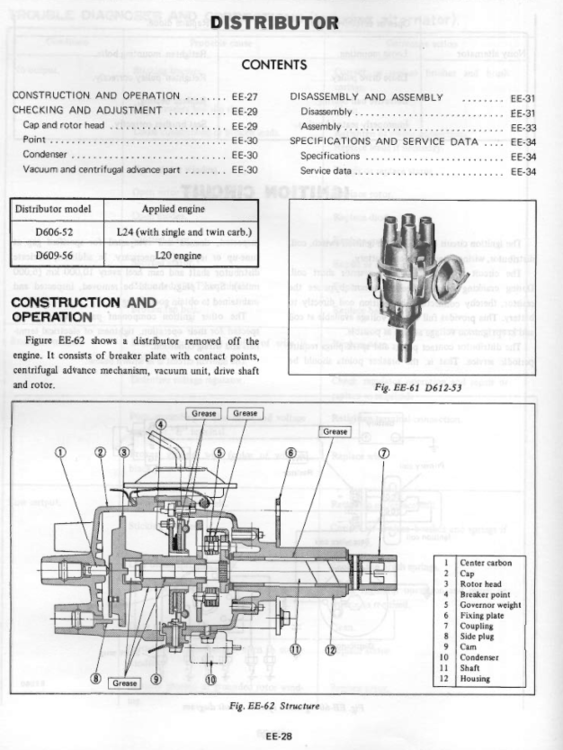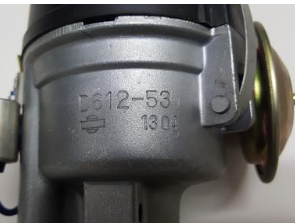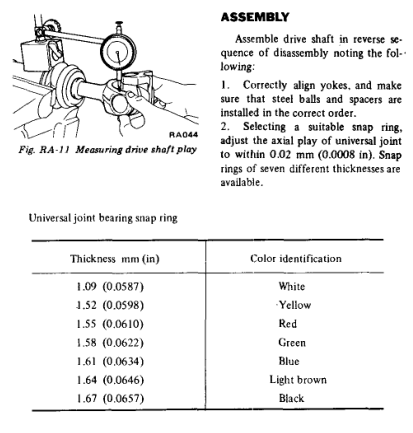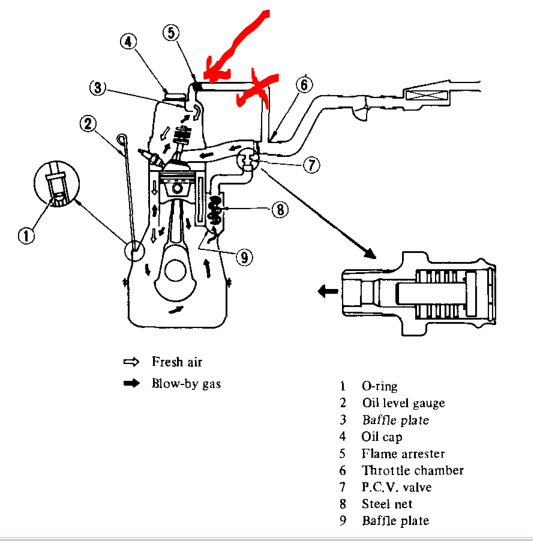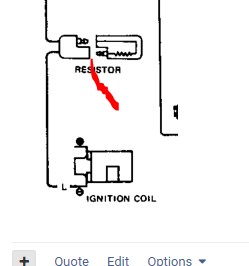Everything posted by Zed Head
-
78 280z turns off with turn signal/reverse lights
Fuel pump control relay loses power on the white/black stripe wire when he shift lever is put in to reverse power is returned as soon as the lever is taken out of reverse Have you tried disconnecting the reverse switch to see what happens? It might not be a high current draw but instead one of the circuits to the control relay is getting grounded, causing the control relay to cut power. The control relay system operation just never sticks in my head. but I think that the oil pressure switch is closed at low pressure, grounding that circuit. Seems like it might be possible that your reverse circuit and oil pressure switch circuit have been swapped. When you actuate the switch, grounding that circuit, it looks low oil pressure to the control relay. Are your reverse lights on when the key is on and engine not running?
-
76 280Z
Curious as to how an EGR intake adds value to a car. Not arguing, just wondering. That logic also says that a catalytic converter adds value. And EFI. Meaning carbs are bad, since all three of those are for cleaner emissions.
-
76 280Z
Not seeing it. Can you snap a picture and point it out?
-
rear driver side brake stuck
Check the wear pattern on the new shoes. I found that my parts store shoes seemed to be made for a larger diameter drum. The contact points were only on the ends of the shoes. Didn't create much friction. You could remove the lock pin and try to spin the spindle pin to get an idea of whether or not it will come out. Some are easy some are not. If it won't spin it won't be easy.
-
rear driver side brake stuck
Sounds fishy...
-
78 280z turns off with turn signal/reverse lights
The fuel pump control system uses the alternator output as a control signal also. So bypassing the oil pressure switch shouldn't have been necessary. Doesn't really make sense, if you're saying that a bad oil pressure switch stopped your fuel pump power., I haven't read the whole thread, it starts off as a turn signal/reverse switch problem.
-
76 280Z
https://portland.craigslist.org/wsc/pts/d/portland-z-coupe/6939839846.html
-
Parts for Sale: NOS Distributor
-
Parts for Sale: NOS Distributor
Maybe it is a Japan market number and the picture got pulled through the translation to English for other markets, unnoticed.
-
Parts for Sale: NOS Distributor
Weird, I looked on that page but didn't notice it. It's just hanging out there in space with no reference to it at all. Like a giant typo.
- Primary charging wire hot and melted
-
Parts for Sale: NOS Distributor
Nissan used the first three numbers to distinguish between manual and auto. D611 and D612. They're both -54. Just an observation. That would put -53 at late 72 or early 73. Or not a Z car.
-
Parts for Sale: NOS Distributor
D612-53 might not be a US market model. Take it apart and look at the numbers on the weights if you want to know more. -53 seems to be about 1973 . Might not even be a Z distributor, could be any L series engine of that time period. 1973 FSM numbers - Yours -
-
Rear Spindle Pin
Was he pounding or using a press? I got fooled on one because the pin was actually stuck in the ribber bushing. So it would move in the cast housing when I pounded on it but the bushing would pull it back. Looked it was stuck in he housing but it was stuck in the bushing. You can put a lug nut on the end of the pin and spin it. Same thread. This will break up rust and get some lubricant moved around. In the end though, many people cut it like he wants to do.
-
U-Joint Locking Clips
You need to remove all of the clips. I think. It becomes clear as you press the joints out. You do press on the end caps but you really need a good fixture to do it right. Sometimes people bend the yokes trying replace the u-joints, then the whole half-shaft might be ruined. If you're near an auto shop they might press them out for you for a small fee and it might be worth it. They can be very very tight. I had to use heat on mine to get some of them out. It's a simple job in concept but difficult in practice.
-
Trouble shooting
They actually have a little bit of carbon buildup starting on the exposed metal at the ends of the threads. Where it's cold. The insulators look good and so do the grounding straps. You can see some ash on the grounding straps and a little color on the insulators. They'll be nice and tan in a few hundred miles.
- 1976 280Z Restoration Project
-
1976 280Z Restoration Project
I think that we're just disagreeing on levels. It's a matter of degree. Tolerating and running clean aren't the same. Many of us have felt that our engines run just fine but they won't pass emissions. The system tolerated the dirty coolant sensor connections or high fuel pressure or whatever the problem was. I like what wheee! is doing but there is a small bit of irony in having a catch can to keep the oil out but possibly running rich at time and carboning up the combustion chamber. But, it's a matter of what you want. The whole point of EFI was to be cleaner. Carbs worked fantastically, but were dirty. Good old Holley double pumpers, squirting loads of extra fuel whenever you hit the pedal. I can nasalize the smell...
-
U-Joint Locking Clips
- U-Joint Locking Clips
Nissan used internal clips. Similar concept except the groove is in the u-joint bearing cap. It's an external circlip instead of internal. On the other side of that yoke in your picture. Don't get them mixed up if you plan to reuse the u-joints. They are precisely ground and come in various thicknesses. Nissan u-joints are very durable, high precision pieces. Better than new aftermarket, in my opinion.- 1976 280Z Restoration Project
Lots of things "work". Without good feedback of air flow to the Haltech computer the system will vary between lean and rich. I think that it will not be a clean-running engine. Kind of like a carbed engine. EFI is about precise air flow measurement and metering of fuel appropriately. I'm saying that it could be better. Haltech sells Haltech.- 1976 280Z Restoration Project
With the passage to the intake manifold open at the PCV valve there will always be high flow through the crankcase to the valve. The valve cover is really just an air filter for that unmetered air. It's only going to act as a vent if blow-by overwhelms the PCV valve. All I'm really saying is that the PCV system was not designed for constant high flow rates. It's a giant vacuum leak with the breather on the top. Sorry, I'm a little bit robotic on the logic stuff. How much oil do those guys catch in their catch cans?- 1976 280Z Restoration Project
If the PCV valve is still connected you'll have a straight shot of outside unmetered air through the valve cover and through the crankcase to the intake manifold, carrying oil vapors with it. The system is designed to be balanced, with only metered air or combustion byproducts in the intake manifold. Better, I think, to block the PCV valve opening and just use the breather as a vent, like it was in the old days. As the engine wears and you get blow-by you might find the breather blowing oil vapor at high revs. Or even early in break-in while the rings are seating.- Possible Electrical Problem?
It would be essentially moot. The ZX distributor has the same functionality, in a smaller package. They're both "high energy".- 1977 280Z Runs Rough and No Tach
Since you've found it you might as well check its continuity to the coil's negative terminal. You can do that by turning the key on and checking for voltage at the female part of the bullet connection after removing the resistor. It's more likely that you just have a bad tach though. - U-Joint Locking Clips
Important Information
By using this site, you agree to our Privacy Policy and Guidelines. We have placed cookies on your device to help make this website better. You can adjust your cookie settings, otherwise we'll assume you're okay to continue.







